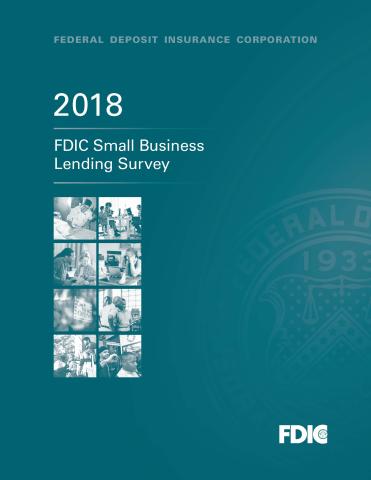
FDIC’s 2018 Report on the 2016 Small Business Lending Survey
The Small Business Lending Survey is a nationally-representative survey of U.S. banks and their small business lending practices. The report of survey findings offers new information for both small and large banks on many aspects of their small business lending. The results provide context for the implications of current bank consolidation trends on U.S. small businesses. Approximately 1,200 banks—more than one-sixth of the FDIC-insured institutions in the United States—responded to the survey.
Further Insights from SBLS 2016
Table of Contents
Acknowledgements
Executive Summary
Section 1: Introduction
Section 2: Defining and Measuring Small Business Lending
- 2.1 Defining Small Business Borrowers: Banks' Approaches
- 2.2 Measuring Small Business Lending (I): Loans That Exceed the Proxy Limit
- 2.3 Measuring Small Business Lending (II): Loans by Banks That Specialize Their C&I Loans to Small Businesses
- 2.4 Measuring Small Business Lending (III): Loans Secured by Residential Real Estate
- 2.5 Extrapolating a Lower Bound on the Proxy's Understatement of Small Business Loans
- 2.6 Conclusions
Section 3: Markets and Competition
- 3.1 What Is Your Bank's Geographic Market for Loans to Small Businesses?
- 3.2 Where Can a Small Business Apply for a Loan from Your Bank?
- 3.3 Who Are Your Bank's Competitors?
- 3.4 Conclusions
Section 4: Competitive Practices and Advantages
- 4.1 How Does Your Bank Maintain and Generate Relationships with Small Businesses?
- 4.2 What Are the Competitive Advantages of Your Bank and of Your Number One Competitor?
- 4.3 Conclusions
Section 5: Loan Products and Underwriting Practices
- 5.1 What Loan Products Does Your Bank Offer to Small Businesses?
- 5.2 For What Purposes Do Small Businesses Use These Products?
- 5.3 Which Underwriting Criteria Are Used by Your Bank to Evaluate Small Business Borrowers?
- 5.4 What Collateral Does Your Bank Accept from Small Businesses?
- 5.5 When Is Your Bank Willing to Make an Underwriting Exception for a Small Business?
- 5.6 Does Your Bank Require Minimum Loan Amounts and Use Standardized Loan Products?
- 5.7 Does Your Bank Lend to Start-Ups, and if so, Do You Underwrite the Loans Differently from Loans for Established Small Businesses?
- 5.8 Conclusions
References
Appendix A: Survey Methodology
- A.1 Sample Selection
- A.2 Survey Response Rate
- A.3 Item Response Rate
- A.4 Analysis and Statistical Precision
Appendix B: Extrapolated Outstanding C&I Lending to Small Businesses
- B.1 Extrapolated C&I Lending to Small Businesses Originated at Amounts Greater Than $1 Million, by Banks with Assets of $1 Billion to Less Than $10 Billion
- B.2 Extrapolated C&I Lending to Small Businesses Originated at Amounts Greater Than $1 Million, by Banks with Assets Below $1 Billion
- B.3 Extrapolated C&I Lending Collateralized by 1-4 Family Residences
Appendix C: Small Business Lending Survey Questionnaire
PDF Help - Information on downloading and using the PDF reader.
